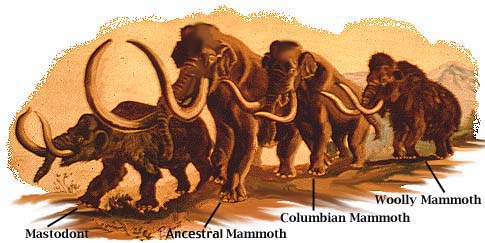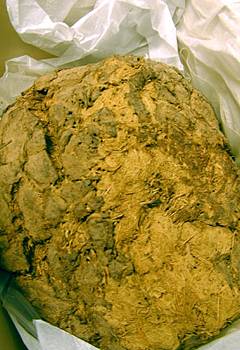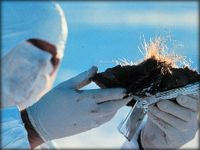

In the not-to-distant past, Columbian Mammoths roamed the Colorado Plateau along with other Ice Age Megafauna. The ecosystem 20,000 years ago was different than today and consisted of grasslands, Blue Spruce and water birch similar to what can be found on some sections of Boulder Mountain today.
The Columbian Mammoth, (Mammuthus columbi ) was a descendent of Mammuthus meridionalis (Mammuthus meridionalis ) the ancestral mammoth that entered North America via the Bering Land Bridge about 1.7 million years ago. The Columbian mammoth ranged from Alaska, and the Yukon, across the mid-western United States south into Mexico and Central America. Huge, standing almost 14 foot at the shoulder (420 cm), and weighing 8-10 tons, the Columbian mammoth could consume about 700 pounds of vegetation a day. The life span for a Columbian mammoth was 60 to 80 years.
Mammoths, mastodonts and elephants emerged from a group of mammals with developed trunks and tusks. This group, called proboscideans, can be traced back to 55 million years ago. Although related, mammoths, mastodonts and elephants are from different branches of this proboscidean ancestral tree. The first mammoths developed in Africa and soon ranged into Europe and Siberia. The ancestral mammoth, M. meridionalis, reached North America about 1.7 million years ago. Over thousands of years, adapting to the North American environment, the ancestral mammoth evolved to become the Columbian mammoth (the American mammoth).

Columbian Mammoth (Mammuthus columbi )...Shoulder Height--12-14 feet, Weight 8-10 tons
Woolly Mammoth (Mammuthus primigenius )...Shoulder Height--9 feet, Weight 7-9 ton

Mammoth Dung From Glen Canyon
A Pleistocene dung blanket found in a dry cave in Glen Canyon National Recreational Area
has been studied by Owen Davis and Paul Martin of the University of Arizona's Department
of Geosciences along with Larry Agenbroad and Jim Mead of the Northern Arizona University
Quartenary Studies Program.
The fossilzed boluses of dung (rich in graminoid stems) are comparable in size and content to African elephant. Two boluses were radiocarbon dated at 11,670 and 12,900 yr B.P., respectively. They are embedded in a 225 cubic meter dung blanket along with fecal remains and hair of ground sloths, artiodactyls, and small mammals. While no diagnostic bones of mammoth were recovered, the deposit yielded long coarse hair attributed to mammoth.
The bolus deposit constitutes a major finds for paleoecologists and are the most impressive discovery of their kind since the discovery in the 1930's of dry caves yielding ground sloth dung in Nevada, Arizona, New Mexico, and west Texas. The cave deposit accumulated during an interval of vegetation change when blue spruce and water birch declined, oak became more abundant, and the regional vegetation was sagebrush steppe. Blue spruce and water birch currently occupy higher elevations in southern, Utah. The last of the Ice Age Megaherbivore population occupation in the Glen Canyon Recreational Area and the Grand Canyon apparently ended about 11,000 years ago.
Small bands of prehistoric Indians, called Paleo-Indian people, roved through the Glen Canyon area at the end of the Ice Age, about 9,000 to 11,000 years ago. Herds of mammoth, large-horned bison, and camels roamed the land, and the climate was cool and wet. As the climate became progressively hotter and drier, the verdant landscape, big game animals, and related hunting opportunities all gradually disappeared.
About 8,000 years ago, major climatic shifts heralded the end of giant wooly mammals like the mastondon, the mammoth and the sabre-tooth tiger.
Excavation of a Columbian Mammoth kill site near Kanab is planned by the Museum of Northern Arizona. The site will be worked as both a paleontolical site and an archeological site.
The Idea - French explorer Bernard Buigues and Larry Agenbroad, Northern Arizona University hope that Jarkov Wooly Mammoth sitting inside a 23-ton block of ice will contain flesh sample with some perfectly preserved DNA. That and some proven cloning technology could resurrect a long-gone species.
What Buigues and his team would do is something similar to the process that created the famous sheep Dolly: extracting the nucleus of one adult mammoth cell and inserting it into an empty egg cell. The embryo would then be implanted in the uterus of an Asian elephant, the mammoth’s closest living relative, a surrogate mother that would gestate it as its own but without transferring to the baby any of the elephant’s genes.
For the past 20,380 years, this 10-foot-tall mammal weighing more than 2 tons has remained buried under 4½ feet of permafrost in the steppes of northern Russia. When the frozen mammoth was pulled out last year, expedition leaders suggested the possible presence of soft tissue would make it possible to clone the extinct animal. There is a lot we can do with even bad DNA.
We believe we have a 100 percent chance of finding parts of the mammoth, which died at 47 years old, still intact,” Buigues said. Its head and trunk were closest to the surface, exposed to climate changes, and they have deteriorated, but not the rest of the body. Its woolly skin is in good condition and we think its internal organs and possibly even its stomach contents are as well.
There should be little problem in getting DNA if the animal is well preserved.

The Reality - Finding intact parts, however, does not necessarily mean finding clonable DNA. Breathing life into the extinct woolly mammoth is likely to be a possibly impossible operation. During life, the damage to fragile DNA is repaired naturally. After death, the genetic code quickly breaks down. Siting in ice for 20,000 years, the water damage, the ultraviolet radiation and the chemical decay will likely shatter your DNA to bits.
Robert DeSalle, a curator at the American Museum of Natural History, calls this the “Humpty Dumpty” problem. These genetic fragments would likely be 10,000 to 100,000 times smaller than the DNA pieces the researchers in the human genome project are working with. Except for a simple flu virus, No organisms have been manipulated this way.
For cloning to work, you need the entire genome be completely intact. Even though
an animal might be frozen for centuries, bacteria and fungi begin colonizing its tissues
from the moment of death and consuming it until all is buried by snow.
http://www.mammothsite.com
http://www.americanparknetwork.com/parkinfo/gp/history.html
ABC
News article on the possibilities of cloning the mammoth